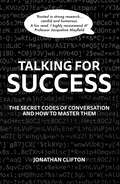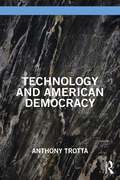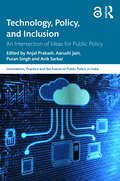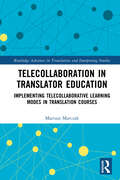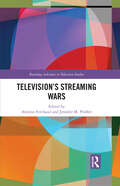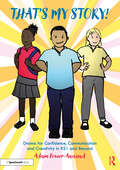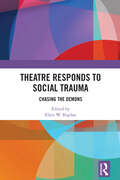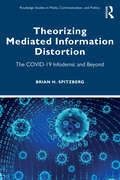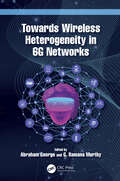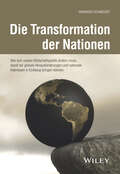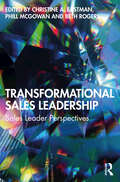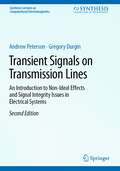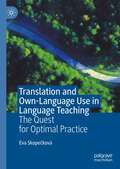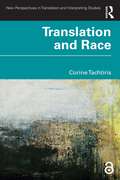- Table View
- List View
Talking For Success: The Secret Codes of Conversation – and How to Master Them
by Dr Jonathan CliftonImagine if you could always get what you want – just by speaking properly. For decades academics have been slowly cracking the secret codes of spoken language used by successful speakers to achieve their aims. Now in this practical and eye-opening guide, Jonathan Clifton, a linguistics expert who has been decoding language for decades, identifies these below-the-radar tactics, explaining how and why they work. And he sets out 100 ways you can successfully apply these secret codes of spoken language yourself, and achieve your goals in life, love and work. Debate, small talk, negotiation, advertising, apologies, presentations, and news interviews, all are revealed in Dr Clifton's prescription for conversational joy. Dr Clifton, an associate professor at the Université Polytechnique Hauts-de-France, France, has been teaching communication to students at universities in Europe and India for the past 25 years. However, he has come to realise that academics are often writing only for each other and their work is often obscure and inaccessible for a wider public. To spread the practical benefits of linguistics, he is bringing the insights of his research to a popular audience in a clear and jargon-free manner. His message is that if you want to improve your communication skills, you must study how other people use language as they go about their daily business. Then you'll be able to crack the codes of conversation for yourself – and talk your way to success. Imagine what a difference that could make to your life. Just by applying some thought and the right words. Reviews "Drawing from years of research and university teaching, Jonathan Clifton masterfully guides the reader through the secret codes of conversation - without the academic jargon. Through easy-to-follow examples taken from contemporary scenarios, this book encourages you to notice the subtlest of cues in language, and it equips you with concrete communication strategies, one hundred of them to be specific. From celebrity interviews to police negotiations, from adverts to everyday chatter - if you ever wondered how people really communicate and how they achieve their goals, you won't be able to put this book down!" Erika Darics, language consultant and Professor of Applied Linguistics, University of Groningen, The Netherlands. "Jonathan Clifton is an outstanding scholar, as his many academic publications attest. Yet, what makes him truly stand out from the 'academic crowd' is his ability to translate complex analyses into plain language. Combine this with an excellent nose for captivating cases, and you have a recipe for success, as this book shows! Because seriously, who wouldn't want to know how to crack the language codes as used by the likes of Boris Johnson, Donald Trump, and Meghan and Harry?! Dorien Van De Mieroop, Professor of Linguistics, Leuven University, Belgium." "This wise book resonates with academics and professionals by showing how communication shapes reality. "TALKING FOR SUCCESS: The Secret Codes of Conversation and How to Master Them" is a one-of-a-kind guide to communication strategy that is both specific and actionable. These very valuable insights are also rooted in strong research but shared in an engaging and conversational tone. To boot, the candid, and sometimes humorous delivery, is a fun read. I highly recommend it!" Jacqueline Mayfield, PhD, Professor Emeritus of Management, Texas A & M International University. Co-Editor, the International Journal of Business Communication
Technical Writing for Software Developers: Enhance communication, improve collaboration, and leverage AI tools for software development
by Chris ChinchillaElevate your software development process with expert technical writing skills, fostering clarity, collaboration, and successful product outcomesKey FeaturesOptimize documentation workflows with collaborative version-controlled "docs-as-code" tooling optionsEngage with interactive learning modules embedded throughout the bookImprove software quality as a lead developer through effective communication in documentationPurchase of the print or Kindle book includes a free PDF eBookBook DescriptionEffective documentation is key to the success of products in remote software development teams, facilitating clear instructions that benefit the entire development team. Technical Writing for Software Developers lays a solid foundation of essential grammar, providing language tips and explaining how precise writing enhances documentation, and walks you through the fundamental types and styles of documentation. Starting with an exploration of the current state of the tech writing industry and its significance in both the software and hardware realms, you’ll master the building blocks of technical writing, exploring tooling choices and style guides, and create dynamic multimedia-laden documentation. This book equips you with valuable insights into the writing and feedback process to ensure continuous improvement. Additionally, you’ll take a peek at the emerging trends and technologies, including AI tools, shaping the future of technical writing. By the end of this technical writing book, you’ll have developed the expertise you need to tackle documentation requests effectively, armed with the knowledge of the best approach for documenting any topic, encompassing text, media elements, structure, and appropriate tools. The skills acquired will enable you to achieve seamless teamwork, enhanced project efficiency, and successful software development.What you will learnCreate engaging multimedia-rich documentationUnderstand the types and styles of documentationDiscover grammar and language tips for clear communicationStreamline your documentation process with the right tooling choiceMaster the writing and feedback process for continuous improvementExplore automation techniques for efficient documentation workflowsEmbrace AI-powered tools for enhanced technical writingWho this book is forThis book is for software developers who want to improve their technical writing prowess. Whether you are a junior developer looking to refine your documentation skills or a professional striving for smoother collaboration, this resource equips you with all the essential knowledge and practical insights you need. Covering everything from creating clear documentation to enhancing career prospects, this book caters to a diverse range of software developers, including programmers, software architects, and software engineers looking to streamline the product development process and save time.
Technology and American Democracy
by Anthony TrottaThe growth and proliferation of technology in American society places new demands on the U.S. government and the health of its democracy, affecting both policymaking and public administration. Technology and American Democracy explores the underpinning democratic theories, including constitutional justifications, that guide decision makers during the application of Information Technology (IT) in governance to promote democratic principles such as transparency and accountability. The book examines the capacity of IT to facilitate deliberative democracy, alter modern bureaucratic structures and functions, and affect areas of public policy including public budgeting and performance measurement. Author Anthony Trotta demonstrates the ways in which technology creates new problems for contemporary government, including a discussion of virtual currency and its possible issues that must be addressed by the public sector. The discussion avoids highly technical language and confusing industry jargon, focusing instead on explaining important concepts in an accessible fashion, applicable to a broad spectrum of readers. Technology and American Democracy is required reading for students enrolled in courses on politics, public administration, and public policy.
Technology and American Democracy
by Anthony TrottaThe growth and proliferation of technology in American society places new demands on the U.S. government and the health of its democracy, affecting both policymaking and public administration. Technology and American Democracy explores the underpinning democratic theories, including constitutional justifications, that guide decision makers during the application of Information Technology (IT) in governance to promote democratic principles such as transparency and accountability. The book examines the capacity of IT to facilitate deliberative democracy, alter modern bureaucratic structures and functions, and affect areas of public policy including public budgeting and performance measurement. Author Anthony Trotta demonstrates the ways in which technology creates new problems for contemporary government, including a discussion of virtual currency and its possible issues that must be addressed by the public sector. The discussion avoids highly technical language and confusing industry jargon, focusing instead on explaining important concepts in an accessible fashion, applicable to a broad spectrum of readers. Technology and American Democracy is required reading for students enrolled in courses on politics, public administration, and public policy.
Technology, Policy, and Inclusion: An Intersection of Ideas for Public Policy (Innovations, Practice and the Future of Public Policy in India)
by Anjal Prakash Aarushi Jain Puran Singh Avik SarkarTechnology, Policy, and Inclusion looks at the intersections between public policy and technology in India. It explores the barriers in instituting effective governance and development and examines how these can be mitigated through technological interventions in developing countries. Increased digitisation of the economy has added to the development challenges in India and issues such as exclusion and social inequality. This volume stresses the need for governments to leverage technology to bring more vulnerable and marginalised groups into the fold of financial and social inclusion. It also focuses on the importance of regulation for a responsible integration of technologies and minimising risks. The book includes examples and case studies from different areas including management of the COVID-19 pandemic through digital means, real estate digital infrastructure, digital census, e-markets for farmers, and government interventions that use technology to deliver financial services in remote areas of the country. It also outlines various solutions for fostering equity and socio-economic development. Part of the Innovations, Practice and the Future of Public Policy in India series, this volume will be of interest to students and researchers of public policy, political science, development studies, and sociology as well as policy professionals and technocrats. This book is freely available as a downloadable Open Access PDF at http://www.taylorfrancis.com under a Creative Commons (CC-BY-NC-ND) 4.0 license.
Technology, Policy, and Inclusion: An Intersection of Ideas for Public Policy (Innovations, Practice and the Future of Public Policy in India)
by Anjal Prakash, Aarushi Jain, Puran Singh, and Avik SarkarTechnology, Policy, and Inclusion looks at the intersections between public policy and technology in India. It explores the barriers in instituting effective governance and development and examines how these can be mitigated through technological interventions in developing countries. Increased digitisation of the economy has added to the development challenges in India and issues such as exclusion and social inequality. This volume stresses the need for governments to leverage technology to bring more vulnerable and marginalised groups into the fold of financial and social inclusion. It also focuses on the importance of regulation for a responsible integration of technologies and minimising risks. The book includes examples and case studies from different areas including management of the COVID-19 pandemic through digital means, real estate digital infrastructure, digital census, e-markets for farmers, and government interventions that use technology to deliver financial services in remote areas of the country. It also outlines various solutions for fostering equity and socio-economic development. Part of the Innovations, Practice and the Future of Public Policy in India series, this volume will be of interest to students and researchers of public policy, political science, development studies, and sociology as well as policy professionals and technocrats. This book is freely available as a downloadable Open Access PDF at http://www.taylorfrancis.com under a Creative Commons (CC-BY-NC-ND) 4.0 license.
Telecollaboration in Translator Education: Implementing Telecollaborative Learning Modes in Translation Courses (Routledge Advances in Translation and Interpreting Studies)
by Mariusz MarczakThis volume provides a comprehensive treatment of telecollaboration as a learning mode in translator education, surveying the state-of-the-art, exploring its distinctive challenges and affordances and outlining future directions in both theoretical and practical terms. The book begins with an overview of telecollaboration and its rise in prominence in today’s globalised world, one in which developments in technology have significantly impacted practices in professional translation and translator education. The volume highlights basic design types and assessment modes and their use in achieving competence-based learning outcomes, drawing on examples from seven telecollaboration projects. In incorporating real-life research, Marczak draws readers’ attention to not only the practical workings of different types of projects and their attendant challenges but also the opportunities for educators to diversify and optimize their instructional practices and for budding translators to build competence and better secure their future employability in the language service provision industry. This volume will be a valuable resource for students and researchers in translation studies, particularly those with an interest in translator education and translation technology, as well as stakeholders in the professional translation industry.
Telecollaboration in Translator Education: Implementing Telecollaborative Learning Modes in Translation Courses (Routledge Advances in Translation and Interpreting Studies)
by Mariusz MarczakThis volume provides a comprehensive treatment of telecollaboration as a learning mode in translator education, surveying the state-of-the-art, exploring its distinctive challenges and affordances and outlining future directions in both theoretical and practical terms. The book begins with an overview of telecollaboration and its rise in prominence in today’s globalised world, one in which developments in technology have significantly impacted practices in professional translation and translator education. The volume highlights basic design types and assessment modes and their use in achieving competence-based learning outcomes, drawing on examples from seven telecollaboration projects. In incorporating real-life research, Marczak draws readers’ attention to not only the practical workings of different types of projects and their attendant challenges but also the opportunities for educators to diversify and optimize their instructional practices and for budding translators to build competence and better secure their future employability in the language service provision industry. This volume will be a valuable resource for students and researchers in translation studies, particularly those with an interest in translator education and translation technology, as well as stakeholders in the professional translation industry.
Television’s Streaming Wars (Routledge Advances in Television Studies)
by Arienne Ferchaud Jennifer M. ProffittThis volume addresses contemporary debates and trends regarding the production and distribution, content, and audience engagement with the television streaming industry. The book interrogates the economics and structure of the industry, questions the types and diversity of content perpetuated on streaming services, and addresses how audiences engage with content from US and global perspectives and within various research paradigms. Chapters address television streaming wars, including the debates and trends in terms of its production and competition, diversity and growth of programming, and audience consumption, focusing on multiple platforms, content, and users. This timely and creative volume will interest students and scholars working in television studies, media industry studies, popular culture studies, audience studies, media psychology, critical cultural studies and media economics.
Television’s Streaming Wars (Routledge Advances in Television Studies)
This volume addresses contemporary debates and trends regarding the production and distribution, content, and audience engagement with the television streaming industry. The book interrogates the economics and structure of the industry, questions the types and diversity of content perpetuated on streaming services, and addresses how audiences engage with content from US and global perspectives and within various research paradigms. Chapters address television streaming wars, including the debates and trends in terms of its production and competition, diversity and growth of programming, and audience consumption, focusing on multiple platforms, content, and users. This timely and creative volume will interest students and scholars working in television studies, media industry studies, popular culture studies, audience studies, media psychology, critical cultural studies and media economics.
That's My Story!: Drama for Confidence, Communication and Creativity in KS1 and Beyond
by Adam Power-AnnandThe ability to communicate is an essential life skill for all children and young people and it underpins their social, emotional and educational development. If a child experiences a positive relationship with an adult listening carefully, they are more likely to constructively share their thoughts, feelings and their imaginative ideas.That’s My Story! places children’s imagined stories at the heart of their own development and provides a joyful, creative approach to support young children’s personal and social development and to encourage their communication. In this book you will find: Tried-and-tested drama games and activities that support communication and well-being, all adaptable to complement your current practice Guidance and advice on how to promote positive adult-child interactions Examples of creative interventions that support children’s communication development A celebration of the joy that comes with carefully listening to children’s own imagined stories Those of us who work with children can sense a tangible connection between how young children feel and how they communicate. This essential and practical resource will be valuable reading for primary teachers, teaching assistants, speech and language therapists, and drama practitioners, as well as outreach and education departments of theatre companies and other arts organisations.
That's My Story!: Drama for Confidence, Communication and Creativity in KS1 and Beyond
by Adam Power-AnnandThe ability to communicate is an essential life skill for all children and young people and it underpins their social, emotional and educational development. If a child experiences a positive relationship with an adult listening carefully, they are more likely to constructively share their thoughts, feelings and their imaginative ideas.That’s My Story! places children’s imagined stories at the heart of their own development and provides a joyful, creative approach to support young children’s personal and social development and to encourage their communication. In this book you will find: Tried-and-tested drama games and activities that support communication and well-being, all adaptable to complement your current practice Guidance and advice on how to promote positive adult-child interactions Examples of creative interventions that support children’s communication development A celebration of the joy that comes with carefully listening to children’s own imagined stories Those of us who work with children can sense a tangible connection between how young children feel and how they communicate. This essential and practical resource will be valuable reading for primary teachers, teaching assistants, speech and language therapists, and drama practitioners, as well as outreach and education departments of theatre companies and other arts organisations.
Theatre Responds to Social Trauma: Chasing the Demons (Routledge Series in Equity, Diversity, and Inclusion in Theatre and Performance)
This book is a collection of chapters by playwrights, directors, devisers, scholars, and educators whose praxis involves representing, theorizing, and performing social trauma.Chapters explore how psychic catastrophes and ruptures are often embedded in social systems of oppression and forged in zones of conflict within and across national borders. Through multiple lenses and diverse approaches, the authors examine the connections between collective trauma, social identity, and personal struggle. We look at the generational transmission of trauma, socially induced pathologies, and societal re-inscriptions of trauma, from mass incarceration to war-induced psychoses, from gendered violence through racist practices. Collective trauma may shape, protect, and preserve group identity, promoting a sense of cohesion and meaning, even as it shakes individuals through pain. Engaging with communities under significant stress through artistic practice offers a path towards reconstructing the meaning(s) of social trauma, making sense of the past, understanding the present, and re-visioning the future.The chapters combine theoretical and practical work, exploring the conceptual foundations and the artists’ processes as they interrogate the intersections of personal grief and communal mourning, through drama, poetry, and embodied performance.
Theatre Responds to Social Trauma: Chasing the Demons (Routledge Series in Equity, Diversity, and Inclusion in Theatre and Performance)
by Ellen W. KaplanThis book is a collection of chapters by playwrights, directors, devisers, scholars, and educators whose praxis involves representing, theorizing, and performing social trauma.Chapters explore how psychic catastrophes and ruptures are often embedded in social systems of oppression and forged in zones of conflict within and across national borders. Through multiple lenses and diverse approaches, the authors examine the connections between collective trauma, social identity, and personal struggle. We look at the generational transmission of trauma, socially induced pathologies, and societal re-inscriptions of trauma, from mass incarceration to war-induced psychoses, from gendered violence through racist practices. Collective trauma may shape, protect, and preserve group identity, promoting a sense of cohesion and meaning, even as it shakes individuals through pain. Engaging with communities under significant stress through artistic practice offers a path towards reconstructing the meaning(s) of social trauma, making sense of the past, understanding the present, and re-visioning the future.The chapters combine theoretical and practical work, exploring the conceptual foundations and the artists’ processes as they interrogate the intersections of personal grief and communal mourning, through drama, poetry, and embodied performance.
Theorizing Mediated Information Distortion: The COVID-19 Infodemic and Beyond (Routledge Studies in Media, Communication, and Politics)
by Brian H. SpitzbergThis book explores the phenomenon of distortion of information through media via the lens of the COVID-19 pandemic, and the ways in which relevant information distortion and virality have occurred in regard to the disease and its risks. Positing that the interrelated processes of misinformation, disinformation, fake news and conspiracy theories are related forms of distortion of information through media (DIM) and can only be understood through a multilevel theoretical model that incorporates message-based, individual difference, social network-based, societal and geotechnical factors, Brian H. Spitzberg develops an integrative, well-argued, and well-evidenced framework within which these issues can and should be addressed. This book offers a model for further research across such disciplines as communication, journalism/media studies, political science, sociology, cognitive psychology, social psychology, evolutionary psychology, public health, big data analytics, social network analytics, computational linguistics and geographic information sciences, and will interest researchers and students in those areas.
Theorizing Mediated Information Distortion: The COVID-19 Infodemic and Beyond (Routledge Studies in Media, Communication, and Politics)
by Brian H. SpitzbergThis book explores the phenomenon of distortion of information through media via the lens of the COVID-19 pandemic, and the ways in which relevant information distortion and virality have occurred in regard to the disease and its risks. Positing that the interrelated processes of misinformation, disinformation, fake news and conspiracy theories are related forms of distortion of information through media (DIM) and can only be understood through a multilevel theoretical model that incorporates message-based, individual difference, social network-based, societal and geotechnical factors, Brian H. Spitzberg develops an integrative, well-argued, and well-evidenced framework within which these issues can and should be addressed. This book offers a model for further research across such disciplines as communication, journalism/media studies, political science, sociology, cognitive psychology, social psychology, evolutionary psychology, public health, big data analytics, social network analytics, computational linguistics and geographic information sciences, and will interest researchers and students in those areas.
Towards Wireless Heterogeneity in 6G Networks
The connected world paradigm effectuated through the proliferation of mobile devices, Internet of Things (IoT), and the metaverse will offer novel services in the coming years that need anytime, anywhere, high-speed access. The success of this paradigm will highly depend on the ability of the devices to always obtain the optimal network connectivity for an application and on the seamless mobility of the devices. This book will discuss 6G concepts and architectures to support next-generation applications such as IoT, multiband devices, and high-speed mobile applications. IoT applications put forth significant challenges on the network in terms of spectrum utilization, latency, energy efficiency, large number of users, and supporting different application characteristics in terms of reliability, data rate, and latency.While the 5G network developmentwas motivated by the need for larger bandwidth and higher quality of service (QoS), 6G considerations are supporting many users with a wide application requirement, lowering network operating cost, and enhanced network flexibility. Network generations beyond 5G are expected to accommodate massive number of devices with the proliferation of connected devices concept in connected cars, industrial automation, medical devices, and consumer devices.This book will address the fundamental design consideration for 6G networks and beyond. There are many technical challenges that need to be explored in the next generation of networks, such as increased spectrum utilization, lower latency, higher data rates, accommodating more users, heterogeneous wireless connectivity, distributed algorithms, and device-centric connectivity due to diversified mobile environments and IoT application characteristics. Since 6G is a multidisciplinary topic, this book will primarily focus on aspects of device characteristics, wireless heterogeneity, traffic engineering, device-centric connectivity, and smartness of application.
Towards Wireless Heterogeneity in 6G Networks
by Abraham George G. Ramana MurthyThe connected world paradigm effectuated through the proliferation of mobile devices, Internet of Things (IoT), and the metaverse will offer novel services in the coming years that need anytime, anywhere, high-speed access. The success of this paradigm will highly depend on the ability of the devices to always obtain the optimal network connectivity for an application and on the seamless mobility of the devices. This book will discuss 6G concepts and architectures to support next-generation applications such as IoT, multiband devices, and high-speed mobile applications. IoT applications put forth significant challenges on the network in terms of spectrum utilization, latency, energy efficiency, large number of users, and supporting different application characteristics in terms of reliability, data rate, and latency.While the 5G network developmentwas motivated by the need for larger bandwidth and higher quality of service (QoS), 6G considerations are supporting many users with a wide application requirement, lowering network operating cost, and enhanced network flexibility. Network generations beyond 5G are expected to accommodate massive number of devices with the proliferation of connected devices concept in connected cars, industrial automation, medical devices, and consumer devices.This book will address the fundamental design consideration for 6G networks and beyond. There are many technical challenges that need to be explored in the next generation of networks, such as increased spectrum utilization, lower latency, higher data rates, accommodating more users, heterogeneous wireless connectivity, distributed algorithms, and device-centric connectivity due to diversified mobile environments and IoT application characteristics. Since 6G is a multidisciplinary topic, this book will primarily focus on aspects of device characteristics, wireless heterogeneity, traffic engineering, device-centric connectivity, and smartness of application.
Transformation der Nationen (AT)
by Reinhard SchneiderJahrzehntelang waren die technologisch fortgeschrittenen Länder des Westens die Nutznießer der Globalisierung auf Basis der von ihnen geschaffenen Wirtschaftsordnung. Jetzt ändern sich die geopolitischen und wirtschaftlichen Verhältnisse mit Wucht. Gleichzeitig hat sich in den letzten Jahren die Erkenntnis durchgesetzt, dass wir unsere Wirtschaft auf CO2-freies Wirtschaften umstellen müssen. Zudem altern viele Gesellschaften. Deutschland und Europa tun sich sichtlich dabei schwer, ihre Nationen zukunftsfähig zu gestalten. Gerade bei der passenden Wirtschaftspolitik hakt es. Reinhard Schneiders These ist: Es braucht in Deutschland und Europa dringend einen politischen, wirtschaftlichen und gesellschaftlichen Wandel. Diesen schaffen wir aber nur, wenn wir die Grundlagen unseres Wohlstands verstehen. Leider ist das Verständnis der wirtschaftlichen Zusammenhänge in der Politik und der breiten Bevölkerung oft lückenhaft und es kommt zu Fehleinschätzungen. Dies beginnt schon bei der mangelnden Unterscheidung zwischen Tätigkeiten, die Kosten für eine Gesellschaft auslösen, und Tätigkeiten, die Einkommen für eine Gesellschaft generieren. Eine wesentliche Ursache ist die Art, wie wir Wertschöpfung und Einkommen von Nationen bzw. Staaten wie Deutschland definieren und messen. Fest steht: Wenn Nationen ihren Wohlstand halten wollen, müssen sie konkurrenzfähig sein. Attraktive und konkurrenzfähige Produkte werden mittlerweile überall angeboten; bei Amazon ist man nur einen Klick vom weltweiten Angebot entfernt. Während die USA und China verstehen, dass sie ihr Einkommen steigern müssen, wenn sie mehr Wohlstand haben wollen, rümpfen die Europäer die Nase über den Neoliberalismus. Sie rufen lieber nach Geld vom Staat oder der EU zur Steigerung der Nachfrage. Auf diesem Weg werden Deutschland und Europa Gefahr laufen, abgehängt zu werden. Das Buch liefert eine längst überfällige Darstellung der Realität der Wirtschaft. Es soll helfen, richtige Entscheidungen zu treffen. Nur so gelingt uns, vor dem Hintergrund der aktuellen globalen Herausforderungen, der Wandel in eine erfolgreiche Zukunft - die Transformation der Nationen.
Transformational Sales Leadership: Sales Leader Perspectives
by Christine A. Eastman Phill McGowan Beth RogersTransformational Sales Leadership: Sales Leader Perspectives offers viewpoints from 12 leaders across the global sales industry, all of which challenge conventional sales models and promote visionary ways of thinking about sales and leadership.The leaders who share their professional stories in the book are from organizations including SAP, Google, Nationwide US, and Royal Caribbean, as well as their own practices, and they represent a new breed of salespeople who are increasingly sought after by organizations which need to transform their practices. They run teams, drive analytics, and improve operational excellence, and their careers rise or fall on getting the right KPIs. Their stories address solutions to age-old sales problems, but they bring a new perspective to the sales function in the digital age. The book focuses on what sales leaders need in order to be innovative. Specifically, the book shows you how to:• Coach sales people through disruption;• Leverage the most valuable habits for success; and• Provide for meaning and purpose in the hyper-connected and volatile sales industry.If you are a sales professional looking to succeed in challenging scenarios, the journeys recounted in this book demonstrate how the landscape of sales has changed and how thinking about sales differently can help you transform your career.
Transformational Sales Leadership: Sales Leader Perspectives
by Christine A. Eastman Phill McGowan Beth RogersTransformational Sales Leadership: Sales Leader Perspectives offers viewpoints from 12 leaders across the global sales industry, all of which challenge conventional sales models and promote visionary ways of thinking about sales and leadership.The leaders who share their professional stories in the book are from organizations including SAP, Google, Nationwide US, and Royal Caribbean, as well as their own practices, and they represent a new breed of salespeople who are increasingly sought after by organizations which need to transform their practices. They run teams, drive analytics, and improve operational excellence, and their careers rise or fall on getting the right KPIs. Their stories address solutions to age-old sales problems, but they bring a new perspective to the sales function in the digital age. The book focuses on what sales leaders need in order to be innovative. Specifically, the book shows you how to:• Coach sales people through disruption;• Leverage the most valuable habits for success; and• Provide for meaning and purpose in the hyper-connected and volatile sales industry.If you are a sales professional looking to succeed in challenging scenarios, the journeys recounted in this book demonstrate how the landscape of sales has changed and how thinking about sales differently can help you transform your career.
Transient Signals on Transmission Lines: An Introduction to Non-Ideal Effects and Signal Integrity Issues in Electrical Systems (Synthesis Lectures on Computational Electromagnetics)
by Andrew Peterson Gregory DurginThis book provides an introduction to transmission line effects in the time domain. Fundamentals including time of flight, impedance discontinuities, proper termination schemes, nonlinear and reactive loads, and crosstalk are considered. Required prerequisite knowledge is limited to conventional circuit theory. The material is tutorial for electrical and computer engineers on the topic of transient signals on transmission lines. Emphasis has been placed on aspects of the subject that have application to signal integrity and high-speed digital circuit design issues, including proper termination schemes to avoid impedance discontinuities, reactive and nonlinear loads, and an introduction to crosstalk.The coverage focuses on the very important topic of transmission line transients which have been de-emphasized in most current textbooks. This book is prepared to supplement traditional texts for advanced students studying electromagnetics and for a vast array of practicing electrical engineers, computer engineers and material scientists with interests in signal integrity and high-speed digital design.In this second edition, examples and new problems have been added throughout. A new chapter on differential transmission lines has also been incorporated
Translation and Own-Language Use in Language Teaching: The Quest for Optimal Practice
by Eva SkopečkováThis book reconsiders the role of translation and own-language use in the EFL (English as a Foreign Language) classroom. It shows prospective teachers how to use the learners’ own language and translation optimally. The author surveys current research about the EFL classroom and presents both a theoretical framework and a didactic model for using translation and learners’ mother tongues. This is done through an action research project, assessing the proposed didactic model for optimal translation practice in English Language teaching (OTP in ELT) through its integration into teacher education. The book will be of interest to students and researchers in the areas of Translation Studies and Applied Linguistics (particularly EFL, ESL, TEFL and TESOL), as well as educators and designers of pre-service training programmes for language teachers.
Translation and Race (New Perspectives in Translation and Interpreting Studies)
by Corine TachtirisTranslation and Race brings together translation studies with critical race studies for a long-overdue reckoning with race and racism in translation theory and practice. This book explores the "unbearable whiteness of translation" in the West that excludes scholars and translators of color from the field and also upholds racial inequities more broadly.Outlining relevant concepts from critical race studies, Translation and Race demonstrates how norms of translation theory and practice in the West actually derive from ideas rooted in white supremacy and other forms of racism. Chapters explore translation’s role in historical processes of racialization, racial capitalism and intellectual property, identity politics and Black translation praxis, the globalization of critical race studies, and ethical strategies for translating racist discourse. Beyond attempts to diversify the field of translation studies and the literary translation profession, this book ultimately calls for a radical transformation of translation theory and practice.This book is crucial reading for advanced students and scholars in translation studies, critical race and ethnic studies, and related areas, as well as for practicing translators.
Translation and Race (New Perspectives in Translation and Interpreting Studies)
by Corine TachtirisTranslation and Race brings together translation studies with critical race studies for a long-overdue reckoning with race and racism in translation theory and practice. This book explores the "unbearable whiteness of translation" in the West that excludes scholars and translators of color from the field and also upholds racial inequities more broadly.Outlining relevant concepts from critical race studies, Translation and Race demonstrates how norms of translation theory and practice in the West actually derive from ideas rooted in white supremacy and other forms of racism. Chapters explore translation’s role in historical processes of racialization, racial capitalism and intellectual property, identity politics and Black translation praxis, the globalization of critical race studies, and ethical strategies for translating racist discourse. Beyond attempts to diversify the field of translation studies and the literary translation profession, this book ultimately calls for a radical transformation of translation theory and practice.This book is crucial reading for advanced students and scholars in translation studies, critical race and ethnic studies, and related areas, as well as for practicing translators.
